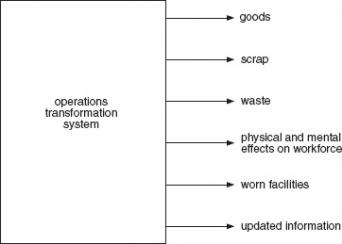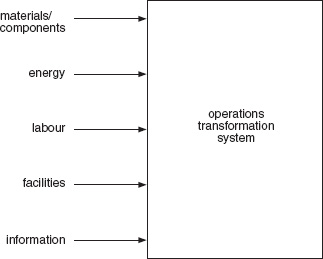3.5 Systems concepts: dynamic behaviour: input-transformation-output
Utilitarian systems, as previously discussed, are the means we use to transform resource inputs into useful goods and services. Any system can be divided into a set of input-transformation-output blocks. These are usually represented as in Figure 31. This way of looking at systems can be used as an analytical and design tool.

SAQ 10
Take a plain blank sheet of paper. In the middle draw a rectangle like this:

Label your rectangle ‘operations transformation system’. From your knowledge of operations, make a list down the right-hand side of the sheet of all the outputs of an operations system that you can think of. Join these to your process rectangle with arrows coming from the rectangle.
Answer
My outputs were:

Transformation processes should always have a verb attributed to them: forming, painting, assembling, packaging are all examples of transformation processes. Transporting is another example, since a component or product is ‘transformed’ from being in one place to being in another.
Outputs are what the system is all about – or at least some of them are. Unless a utilitarian system produces goods, services and information, and produces them in the right quantity, at the right time, of the appropriate quality and at planned cost, its purchasers or creators might as well save their time, money and effort.
SAQ 11
-
(a) From your knowledge of operations, make a list down the left-hand side of the diagram that you drew in answer to SAQ 10 of all the important inputs to the system. Connect them to the operations system rectangle with arrows.
-
(b) The inputs to the transformation system are of three sorts:
-
those that it uses;
-
those that it transforms;
-
those that it uses for planning and control.
-
Decide which of the inputs in your answer to (a) are used by the system, which are transformed, and which are used for planning and control. Then compare your diagram and responses to the ones given in the answers to SAQs 10 and 11.
Answer
-
(a) My diagram looked like this:

-
(b) The inputs that the system uses are:
-
energy
-
labour
-
facilities.
The inputs that the system transforms are:
-
materials/components.
The input that the system uses for planning and control is:
-
information.
-
There are three reasons for getting you to carry out the input–transformation process–output exercise in SAQs 10 and 11.
-
to make you think about systems engineering in terms of inputs, processes and outputs;
-
to introduce input–output diagramming, which is a common technique used in the analysis and development of systems;
-
to illustrate how using tools of this kind can help you to think in a holistic way about a system and can promote further analysis.
Look again at the outputs shown in the diagram associated with the answers to SAQs 10 and 11. Some of the outputs are planned, some are accepted and some are undesirable. It would be possible, for example, to carry out a further, more detailed, analysis on the scrap and waste producing sub-system.
Input–output diagrams are good for identifying and analysing sub-systems, highlighting relevant systems in the environment, and for examining interactions between the various elements that have been identified.
